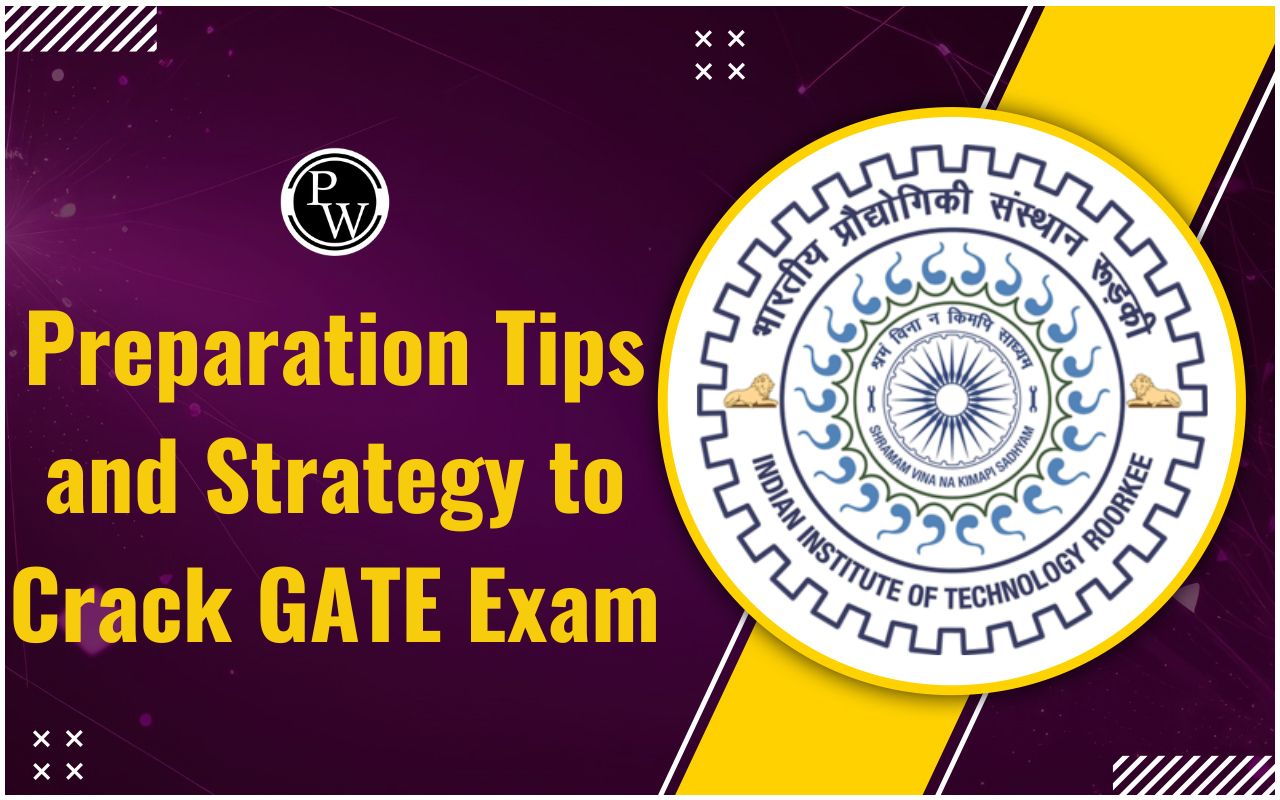Circles in Maths: Explore Properties, Formulas, and Practical Examples

Circles in Maths: A circle is a two-dimensional shape in geometry where every point on its boundary is equidistant from the center. In simple terms, a circle is a collection of all points in a plane that are the same distance from a fixed point, known as the center. The area of a circle is given by pi times the square of its radius. This is the circle definition that lays the foundation for understanding its various aspects.
In this article, you will learn more about the definition of a circle, key formulas for circles, and explore different circle examples. We will also delve into the properties of circles and explain the circle properties that make this geometric shape unique. Additionally, we will address the question of what defines a circle and provide practice problems to enhance your understanding.
Check out: PW School Books
What is a Circle?
A circle is a simple, symmetrical shape with no sharp angles or endpoints. All points along the edge, or circumference, are at an equal distance from the center, known as the radius. The diameter, which is a straight line passing through the center, stretches across the circle and is exactly twice the length of the radius. Circles are essential in geometry, used to calculate key measurements like area and circumference. You’ll find circles everywhere in daily life, from the faces of clocks to the design of buttons on a shirt!
Check out: Class 9th Books
Circle Definition
A circle is a two-dimensional geometric shape made up of all points in a plane that are equidistant (the same distance) from a fixed point known as the center. The distance from the center to any point on the circle is called the radius.
|
Term |
Description |
|
Circumference |
The boundary of the circle is known as the circumference. |
|
Radius |
The line from the center "O" of the circle to the circumference is called the radius, denoted by "R" or "r". |
|
Diameter |
The line that passes through the center of the circle and touches two points on the circumference is called the diameter, denoted by the symbol "D" or "d". |
|
Arc |
An arc is a part of the circumference; the largest arc is called the major arc, and the smaller one is called the minor arc. |
|
Sector |
A sector is a slice of a circle bounded by two radii and the included arc of the circle. |
|
Chord |
A straight line joining any two points on the circumference of a circle is called the chord. |
|
Tangent |
A line that touches the circumference of a circle at exactly one point is called the tangent. |
|
Secant |
A line that cuts the circle at two distinct points is known as the secant. |
How to Draw a Circle?
Drawing a circle is one of the most fundamental construction tasks introduced to students. To construct a circle, you will need a few basic tools, including:
-
Ruler or Scale
-
Pencil
-
Compass
Follow these simple steps to draw a circle:
Step 1: Attach the pencil to the compass, ensuring the pencil tip and compass point are properly aligned.
Step 2: Mark a point on the paper, which will serve as the center of the circle.
Step 3: Use the ruler to measure the radius of the circle and adjust the compass to the desired length.
Step 4: Place the compass point on the center mark and draw the circle by rotating the compass around the center point.
Also Check: CBSE Class 10th Books
Circle Properties
-
Two circles are said to be congruent if they have equal radii.
-
The diameter of a circle is its longest chord.
-
Equal chords of a circle subtend equal angles at the center.
-
A radius drawn perpendicular to a chord bisects the chord.
-
Circles with different radii are similar.
-
A circle can circumscribe a rectangle, trapezium, triangle, square, or kite.
-
A circle can be inscribed inside a square, triangle, or kite.
-
Chords that are equidistant from the center of the circle are equal in length.
-
The distance from the center of the circle to the longest chord (the diameter) is zero.
-
The perpendicular distance from the center of the circle decreases as the length of the chord increases.
-
Tangents drawn at the ends of the diameter are parallel to each other.
-
An isosceles triangle is formed when the radii joining the ends of a chord to the center of the circle.
Formulas for Circles
1. Circumference of a Circle:
-
Explanation: The circumference of a circle is the total distance around its boundary. It is calculated by multiplying the radius (r) of the circle by 2π (where π≈3.14159). The radius is the distance from the center of the circle to any point on the circumference.
2. Area of a Circle:
-
Explanation: The area of a circle represents the total space enclosed within the circle. It is calculated by multiplying π by the square of the radius (r2). This formula tells you how much area is covered by the circle’s boundary.
3. Diameter of a Circle:
-
Explanation: The diameter is the straight line that passes through the center of the circle and touches both sides of the circumference. It is always twice the length of the radius, so the diameter D can be calculated by multiplying the radius r by 2.
4. Length of an Arc:
-
Explanation: The length of an arc is the portion of the circumference between two points on the circle. The formula calculates the length of an arc based on the central angle θ (in degrees) that subtends the arc. To find the length of the arc, multiply the fraction θ/360 by the full circumference 2πr.
5. Area of a Sector:
-
Explanation: A sector is a region inside the circle that is bounded by two radii and the arc between them. The area of a sector depends on the central angle θ (in degrees). The formula calculates the fraction of the total area of the circle that corresponds to the given central angle.
6. Area of a Segment:
-
Explanation: A segment of a circle is the area between a chord and the corresponding arc. The formula for the area of a segment involves two parts: the first part calculates the area of the sector, and the second part subtracts the area of the triangle formed by the chord and the radii. The angle θ should be in radians for the sine function.
7. Equation of a Circle (Standard Form):
-
Explanation: The equation of a circle in standard form represents all the points (x,y)that are at a fixed distance rrr (the radius) from a central point (h,k). The point (h,k) is the center of the circle, and r is the radius. This formula is useful in coordinate geometry for graphing circles and solving problems related to the circle’s position on the coordinate plane.
Check out: CBSE Class 12th Books
Types of Circles
1. Concentric Circles: Concentric circles are circles that share the same center but have different radii. The circles are nested inside one another, and the distance between them remains constant. An example of concentric circles is a dartboard, where all circles are centered at the same point.
2. Tangent Circles: Tangent circles are two circles that touch each other at exactly one point. There are two types of tangent circles:
-
Externally Tangent Circles: The circles touch from the outside.
-
Internally Tangent Circles: One circle lies inside the other, and they touch at a single point.
3. Secant Circles: Secant circles are two circles that intersect at two distinct points. Unlike tangent circles, they do not touch at just one point but cross each other at two locations.
4. Eccentric Circles: Eccentric circles refer to circles with different centers. While the circles may have the same radius or different radii, they are not concentric and do not share the same center.
5. Great Circle: A great circle is the largest possible circle that can be drawn on a sphere. It divides the sphere into two equal hemispheres. On Earth, the equator is an example of a great circle, as it divides the planet into the Northern and Southern Hemispheres.
6. Small Circle: A small circle is any circle on the surface of a sphere that is not a great circle. Unlike the great circle, a small circle does not divide the sphere into two equal hemispheres. An example is a circle of latitude (except the equator) on Earth.
7. Circle of Apollonius: A circle of Apollonius is a circle that can be defined by the property that for any point on the circle, the ratio of the distances to two fixed points (called foci) is constant. These circles arise in problems related to distances and ratios.
Circles in Maths FAQs
1. What is a circle?
A circle is a two-dimensional shape in geometry, where all points on the boundary are equidistant from a fixed central point. The distance from the center to any point on the circle is called the radius.
2. What is the difference between a radius and a diameter?
The radius is the distance from the center of the circle to any point on the circumference. The diameter is twice the length of the radius and is the longest chord that passes through the center of the circle.
3. What is the difference between a secant and a tangent to a circle?
A secant is a line that intersects the circle at two distinct points. A tangent is a line that touches the circle at exactly one point and does not cross it.
4. What is the central angle of a circle?
A central angle is an angle whose vertex is at the center of the circle, and its sides (radii) intersect the circumference at two distinct points.
5. What is a chord in a circle?
A chord is a straight line segment that joins any two points on the circumference of the circle. The diameter is a special type of chord that passes through the center.









